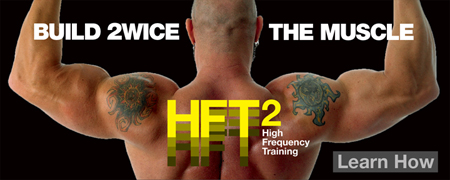 One of the best triggers for muscle growth across your entire body is a full-body workout. When the intensity and volume are dialed in correctly, it’s a powerful stimulus to ramp up protein synthesis and strengthen your muscles and tendons.
One of the best triggers for muscle growth across your entire body is a full-body workout. When the intensity and volume are dialed in correctly, it’s a powerful stimulus to ramp up protein synthesis and strengthen your muscles and tendons.
First, let’s clarify what qualifies as a full-body workout. It’s a combination of exercises that target all your major muscle groups in one training session. In most cases, it’s most effective to program an upper-body push, upper-body pull and a squat or deadlift or lunge variation. This structure is the basis for my Huge in a Hurry book.
Now, you might be thinking that you don’t have the time or equipment to do all those movements in every training session.
Actually, a full-body workout can be performed with as little as one dumbbell. Here I demonstrate a combination of an overhead press/split-stance row/reverse lunge to show how simple your programming can be.
For the sequence shown in the video, you could perform 5 reps of the overhead press and 10 reps of the row and lunge. Repeat for 3 to 5 rounds and alternate between limbs for each exercise. Or you could perform 3 sets of as many reps as the load allows for each exercise, assuming you have access to only a few dumbbells.
Perform three training sessions per week, using different exercises for each workout. If you’re an in-season athlete, two sessions per week is often ideal to manage fatigue and give you adequate time for practice and recovery. If you’re a trainer, it’s important to know which corrective exercises will help keep your athletes resilient to injury. That is why it’s so beneficial to become a Corrective Exercise Specialist. With that in mind, let’s move on to some advanced programming strategies.
Advanced Full-Body Training
People with a few years of training under their belt can ramp up their full-body training to four sessions per week. I’ve written extensively about full-body training over the years, and I keep experimenting with ways to make it better. Here are some advanced strategies I’ve learned to make full-body training your go-to system for fast muscle gains:
1. Perform 4 Workouts per Week
Since most programs have you train a muscle group 2-3 times per week, my definition of High Frequency Training (HFT) is to train 4 or more times per week. With full-body training I’ve found that 4 workouts per week works great for people that want to build muscle and strength quickly.
The key, of course, is recovery. When you train 4 days per week it doesn’t allow you to always have a full day off between each workout. The most effective schedule I’ve used is 2-on, 1-off, 1-on, 1-off, 1-on and 1-off (e.g., Mon/Tue/Thur/Sat).
So that means the first two workouts that are back-to-back must complement each other. Put another way: the first two workouts need to be drastically different from each other to avoid overtraining. You can’t lift heavy both of those days, and trying to lift heavy a day after you performed high reps isn’t good, either. Here’s a sample set/rep combination that’s works well for the first two workouts:
Day 1 (Monday): 5 sets of 5 reps (5×5) for an upper-body pull, push and squat/deadlift/lunge. A chin-up/dip/deadlift circuit fits perfectly here. As a general rule, Day 1 will consist of 6 or fewer reps per set.
Day 2 (Tuesday): 4×12 for a different variation of the upper-body pull, push and squat/deadlift/lunge. Now, we must use different movement patterns compared to Day 1, so a good example for Day 2 is: inverted row/shoulder press/reverse lunge. This day I typically have the sets range from 10-15 reps.
Day 3 (Thursday): Now we’re up to the third workout of the week. It’s been 48 hours since the last workout that consisted of higher rep sets with lighter loads. So on this day you can train heavy to create a different stimulus. Anywhere from 5-10 sets of 3-6 reps is ideal. Three examples are 10×3, 8×4 or 6×6. If you’re someone that prefers to stick to a few compound movements, this day can consist of the same exercises as Day 1.
Day 4 (Saturday): On this day I’ll use all sorts of combinations. Many people want this to be their toughest workout of the week since they typically have extra time to train on Saturday and can sleep late and lie around (naps!) on Sunday. Some examples for Day 4: repeat the Day 2 workout but increase the number of circuits (sets), train Olympic lifts, or create an full-body circuit of the sled push/pull-up/dip after completing 6-8 sets of an Olympic lift heavy deadlift/front squat variation that’s different than you did on Day 1.
2. Arrange Targeted Training Correctly
I’m a huge proponent of full-body workouts for the “core” of your program, but it’s not necessary to train everything all the time. There are times when you’ll want to target a certain muscle group such as the calves, biceps or chest. The fastest way to build a muscle group is to train it more frequently.
For the targeted training workouts, start with any exercise you like for the muscle you’re trying to build (e.g., dumbbell biceps curl). Then choose a load that allows around 12 reps for your first set. Perform 50 total reps per day, regardless of how many sets it takes (you can do 25 reps in the morning and 25 reps in the evening).
Each day add one rep to the total and continue for 4-6 weeks (take a full day off from the targeted training each week). It’s best to do these targeted workouts at least 6 hours before or after your full-body training.
That’s how I approached targeted training in my original HFT system. But now I use even more effective muscle-building strategies to target underdeveloped muscles in half the time.
If you’d like to learn more ways to create full-body workouts with targeted training plans that only take 5-10 minutes per day, check out my latest system HFT2.

Stay Focused,
CW
